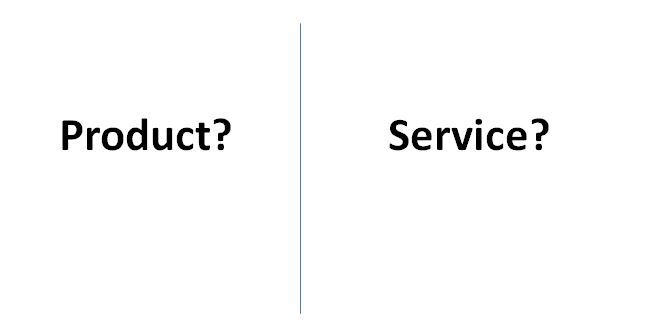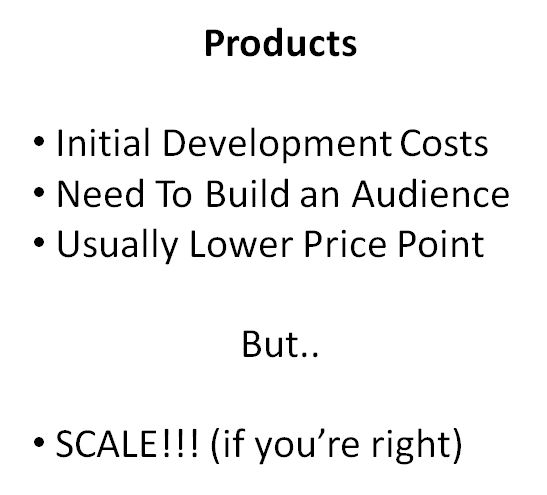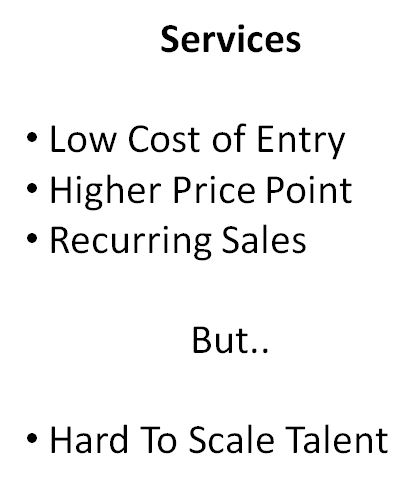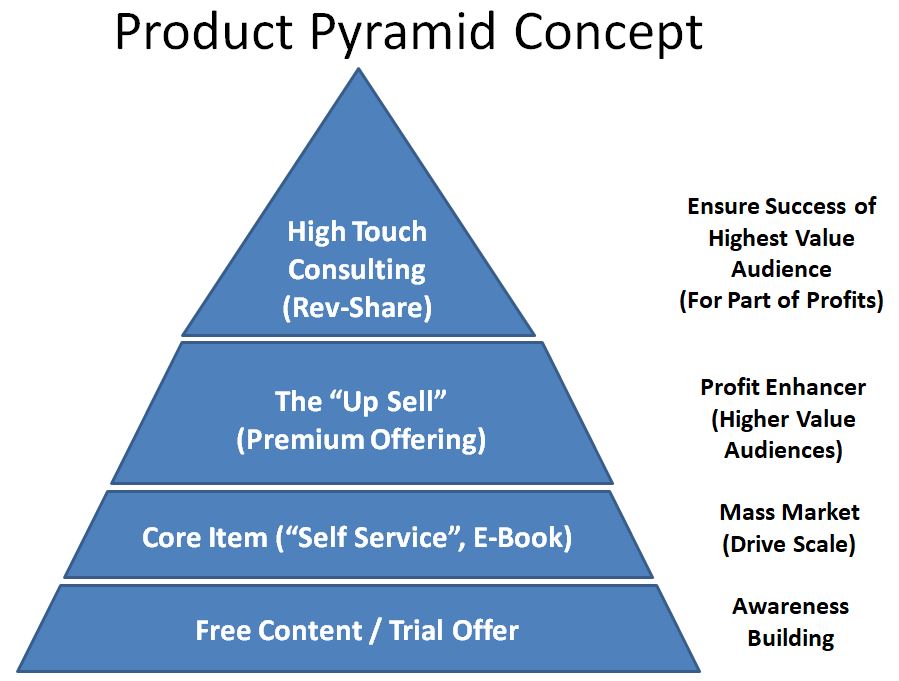These days, information and expertise is one of the best commodities online. Let’s say that you already have an expert level of knowledge in a specific, in-demand niche like online business or digital marketing. Or, let’s assume you have an expert level marketing skill like traffic generation or copywriting, and you know businesses will greatly benefit. The problem is, you know you want to monetize your knowledge and skill set, but you aren’t quite sure which direction you should go in.
This guide is going to help you learn about the pros and cons of both selling products and selling services. It’s going to help you figure out which would be best for your business, and also give additional tips to leverage both business models and maximize your income.
Product vs Service
While there are many sub-models within each of these main business models, deciding if you want to start a service-based business or sell a product is the first big question you need to answer.

Should you start a done-for-you service, start landing clients and helping them with their businesses? Should you sell an informative training course that teaches what you know to people who are eager to learn so they can do it themselves? Should you start a hybrid of both a product and a service like a high-end course that includes one-on-one coaching?
Chances are, you may already be leaning towards one of these already. However, let’s cover the pros and cons of both products and services so you can make a proper, informed decision.
Benefits of Selling a Product
Creating a product let’s you teach people who want to know what you know, and want to develop the skills that you have. They can then do things for themselves and you don’t have to trade your time for money like a done-for-you service.
Selling a product is all about scaling. With a product, your income is no longer tied to your time. You can sell hundreds or thousands of units of your informative training course in the same time that you can work with a handful of clients.
With a product, you can scale much larger while still working alone. It will be longer before you need to hire a team to help with customer service or other responsibilities. Even when you do need help with customer service or things like that, there are companies and people you can outsource this work to. You don’t need to hire employees directly. If you are interested in staying a one person operation even when you scale, selling a product has a distinct advantage.
Obstacles of Selling a Product
It can be much more difficult starting a product-based business like a training course when first starting out vs starting a service-based business. First, you actually need to create a product to sell. This takes time and energy. There is always the chance that you spend all that time and energy creating your training course, just to find out that nobody is actually interested in buying your product.

If you’re starting from scratch, you don’t already have an audience of people to buy your product. This means you need to put either a lot of time or a lot of money into generating traffic so you have people to actually promote your product to. Usually, you’re spending an abundance of both time and money before you even begin making sales.
When you’re selling a product like a training course, at the very minimum, you’re going to need a website, hosting, and a means to deliver your course. On top of that, you’ll probably also going to need to pay for an email autoresponder and additional sales funnel software to help turn your leads into customers.
While you can charge quite a lot for a great product, it’s unlikely you’re going to be able to charge anywhere near as much as a done-for-you service. Of course, this can be made up for in sales volume, but it will be awhile before your sales are high enough to see this benefit.
Sales can vary wildly from month to month, so you have to keep this in mind when you are paying yourself. In the beginning, you can’t spend everything that you’re making, you need to save a lot more in case sales take a big dip. You also need to reinvest more of your profits to grow in comparison to a service.
Benefits of Selling a Service
You can decide to start selling a service right now and be in business today. To sell a service, you don’t need a website, any expensive software, you only need clients.

A service-based business has an extremely low overhead. You can start getting clients without any need for paid advertising. Walking into businesses or cold calling is an excellent way to get your first several clients. You don’t really need any upfront capital to start a service business, unlike selling a product.
With a service, you can get clients to sign up for regular monthly retainers. This means that you have a better idea of how much money is coming in every single month. It allows you to rely on a more steady income, and the financial stability means you have better long term security.
While reinvesting your profits can be beneficial, you won’t need to reinvest nearly as much to grow because you can continue using the same methods to land more clients. On top of this, you’ll likely start getting new clients referred to you with no additional client acquisition costs.
People will pay a lot more for a done-for-you service than they will for a product. The product requires them to do more learning and do the work themselves. Your service lets them rely on you, frees up their time, and reduces the amount of problems they have to deal with. If your service is directly contributing to them making more money in some way, they will be more than happy to pay your higher fees.
In most cases, starting a service-based business allows you to make a larger amount of money right at the beginning compared to selling a product.
Obstacles of Selling a Service
Your income is based on your time. While you are likely charging some kind of flat monthly fee for your services, or maybe even a per project rate, in the end you only have so many hours in a day. You can continue raising your prices, but there is usually a soft limit that you can raise your prices and still remain competitive. Raising your prices beyond these soft industry limits require you to be one of the best in your industry and be good at landing bigger clients. At that point, you will be directly competing with large marketing agencies, which is a whole different level of the game.
Because of this limitation with your time, it can be difficult to scale beyond a certain point. You’ll either need to go the agency route and start hiring and training employees to handle more clients, or you’ll need to become a rock star in your field so you can successfully charge obscenely higher rates than your competitors. Usually, massive success when scaling a service will require a bit of both of these.
Building a Product / Service Pyramid
What if we took a broader view of the opportunity?
There’s our core “mass market” offering, of course. The basic version of the product which can be scaled and deployed to a broad audience.
Many of you will also need a free trial version of the product as well, to help convince new prospects to give your offering a try. If you’re selling information, this will be the “free” version of your material you post as blog content or give away to get an email. For those of you selling software as a service, this is a free “trial account” with limited features and usage that you give a new customer. For CPG entrepreneurs, this is the “free trial size” you can give away.
Those two layers form the base of what we’re going to call a product pyramid. The next two layers we’re going to add will be driven by two additional considerations: customer willingness to pay (cash) and required customer effort (time).

Some customers may see greater value in your program or service and are willing to invest additional funds. This might be an audience for a coaching element. This can be one-on-one coaching or small group mastermind training sessions. The price for a premium hybrid course like this would be somewhere in between your individual course price and your done-for-you service and consulting price. This middle tier pricing allows you to maximize your earnings with a subsection of the people who are interested in getting help with their business and have the funds for a premium experience, but they still can’t quite afford the done-for-you service that you provide. In addition to this, you might be able to help these premium students grow their businesses enough that eventually they can afford your top tier done-for-you services.
For the highest tier of your service offering, you’re willing to take personal ownership of the customer’s implementation of your ideas. For an information business, this would include personal consulting time. For a software product, you would personally direct the implementation of your system within their organization. Your pricing should reflect this.
For your high-end service, keep in mind that at a high level you should be including a percentage of sales as part of your payment to maximize your earnings. If your service directly helps business make money in some way, charge your normal rate along with an ongoing percentage of all their sales.
Which Should You Start?
When it comes to product vs service, starting a service is usually a safer bet when you’re just starting out. This is especially true if you have little to no capital, but you have an abundance of time. If you want to start a business and need a reliable income within your first month or two, start a service. Depending on your prices, you usually only need two or three clients that pay a monthly retainer for your services to make as much as you would doing that same kind of work as an employee.
If you have your heart set on creating a product because of the benefits listed previously, you just need to make sure you have enough startup capital to cover your higher costs. You’ll also likely need to rely on your savings to float you longer before you’re making a steady monthly income.
When deciding which is best for you, you should also take into consideration if you still have a day job when starting your business. If you already have a steady paycheck coming in from your employer, you can afford to spend a bit more money and wait a little longer to get your product-based business off the ground. If you’re not currently working and don’t have a steady paycheck to rely on, a service-based business is a much faster and more efficient solution.
However, there is a third option that let’s you leverage both.
Start A Service, Transition To A Product
One of the best strategies out there is to start a service first, and later start selling a product as well. This eventually let’s you benefit from both, and minimizes the downsides of each type of business.
By starting a business first, you can start getting money coming in every month. This cash flow is essential if you don’t have a day job or you want to quickly quit your day job so you can 100% focus on your business.
Once you have clients that you are helping and your workload is getting full, you can begin creating a product that teaches the exact thing that you are doing for your clients. This will allow you to scale your business without the need to start hiring a team to grow an agency. Your product will be perfect for clients that need help but can’t afford your done-for-you-service. This will help maximize your profits by being able to help customers and clients with varying budgets.
Because you already helped clients with your service, you already have tons of data and case studies to make sure your product is built to a high standard. It also gives your course more legitimacy. People will be more likely to buy it from someone who is actually doing it instead of just teaching it.
The product that you are selling also helps your service as well. By selling a product that teaches what you do for clients, it positions you even more as an expert and a leader in your field. This makes it easier to land clients due to this additional authority, and more importantly, it allows you to charge much higher for your services. In turn, you can then also charge more for your products, because it’s still such a good value in comparison to your high consulting fee.
This method of starting a service-based business and then expanding into creating a product is clearly mutually beneficial and the synergy between them makes the whole greater than the sum of its parts.